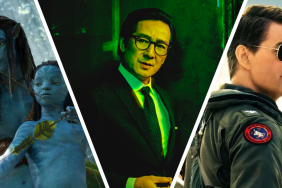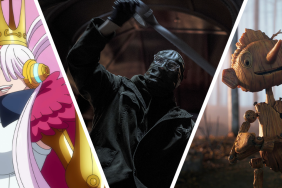
SHOCK looks at movies where crazed animals work for (and against) equally crazed humans.
A majority of ecological disaster films and natural horror movies depicted natures attack (either inexplicable or caused by man in some way) as a direct linear attack – in other words, nature targets humankind and humankind has to defend itself from this tyranny. In these films its a case of man versus nature. However, there are some films where people are so in tune with nature that they become an extension of the natural world and play a major part in the evil and eventual harm it can inflict. In these movies, humans call upon animals as their familiars to work for them, to become their disciples of dirty goings-on. The human stars co-exist with these monstrous animals and usually their intense co-dependence ultimately serves as their own personal downfall in the final reel. Their bestial counterparts serve them and take heed of their direction, but then come the closing moments of the movie these once faithful beasts may rebel or just become too hard to control.
Lets take a look at ten of these eco-horror films that employ this narrative device:

BLACK ZOO (1963)
Starring the always wonderful Michael Gough, BLACK ZOO is a gloriously lit movie, boasting crisp colors, that centers on Goughs connection to large jungle cats like lions, leopards and panthers. He also shares a strong affinity with a large ape as played by the magnificent monkey man George Barrows. All these animals are part of his private zoo and not only are they well-loved and looked after by the obsessive Gough, they are also worshipped. In this movie, animal-worship cultists and all that comes with this particular religious affinity is the fierce focal point and the film remains captivating from the get go. BLACK ZOO, with its vibrant visual flair, is a strange and extremely entertaining little movie and marked the third and final collaboration between producer Herman Cohen and Michael Gough the other movies they worked on together were HORRORS OF THE BLACK MUSUEM and the simian sensation KONGA. Gough is just so much fun to watch in this movie, and you can clearly tell he is having a ball with this material. His extreme broad acting decisions and crazed antics are just as much of a spectacle as the lions and cheetahs tearing apart the folk that get in his way. There are also some great performances from character actors such as Elisha Cook, Virginia Grey and Ed Platt. And the animals are just a sheer delight to watch as they obey every command Gough makes; taking heed in what he says and slaying those who do him wrong. The animal training used in this film is perfectly executed; sometimes it looks far too real when a large powerful cat lunges at a hapless victim. One of the most oddball (and yet incredibly moving) moments in the film is a funeral hosted for a big cat that was killed with the fellow felines mourning, listening to the sermon as recited by their human counterpart Gough.

WILLARD (1971)
Based on the atmospheric novel The Ratmans Notebooks written by Stephen Gilbert, WILLARD is a flawlessly plotted Faustian tale of a social misfit who finds solace in local rats that soon become his army of vengeance. WILLARD precedes superlative horror movie outings such as George A. Romeros vampire classic MARTIN and Brian De Palmas iconic CARRIE as a dynamic character study where the horror grows from someone who is tormented simply because of who they are. It is also a cautionary tale about the dangers of wish fulfillment and a modern American gothic set in the world of the humdrum mundane. In WILLARD, work and unemployment, home ownership, financial woe and the anxieties bought on by becoming a responsible adult in a cruel and unforgiving world are all contributing factors of a very tangible horror – and the rats that serve as the featured grotesque embody these very real fears, but are also used as answer to solve these problems. Willard Stiles is the Pied Piper of Hamlin turned malevolent and demented; however he doesnt start out sinister at all, his descent into unhealthy codependency on his furry friends is made all the more terrifying by Davisons electrifying performance. Davisons Willard Stiles is a likeable loser; angry and edgy, moody and stuck in a permanent rut, the boy is a pathetic sod with a domineering but ailing mother, a menace of a boss and the ghost of his dead father forever haunting him. To the manic rat race, Davisons Willard is a lost cause. He is an unremarkable nobody whose tomorrows will bring him only more sorrow. But all this changes when he meets Socrates, a white rat who takes a shining to the young human loner. Socrates proves to be a charming companion and soon enough more rats appear and the rodent enthusiast forms a special bond with these Los Angeles dwelling vermin. But then along comes Ben; the black independent rat. Ben is not one to be lead by those accursed with no fur, no tail and only two legs. Bruce Davison is perfect in the role of Willard. He moves with awkward twitchiness that at times resembles the jittery nervousness of rats – his convulsing with uneasiness and his inoffensive good looks complimented by his doe-eyed sadness are all heightened and perfectly realized in this wonderful characterization of a young person who goes from pathetic man-boy to brooding victim to vengeful golden haired warlock. Willard was successful both critically and box office wise. Audiences who at the time were flocking to see Francis Ford Coppolas THE GODFATHER, Bob Fosses CABARET and Peter Bogdanovichs THE LAST PICTURE SHOW wholeheartedly embraced it. The films appeal is truly connected to an audiences keen interest and devotion to the underdog rising above adversity that would soon be embodied in movies like ROCKY and in horror movie fare such as the aforementioned CARRIE and the other genie-in-the-lamp treat CHRISTINE.

BEN (1972)
A direct sequel to the superlative WILLARD, BEN is an oddity of a film, featuring a strange mix of cutesy child-centric cinema and made for TV monster of the week. It most certainly lacks the compassion and intelligence of its predecessor and is almost completely devoid of the creepy and kooky malice of the first film. BEN leaves you wondering how a very strong precursor can be succeeded by such a benign follow up that has no real tension whatsoever. However, it is not without its charms, and despite its lack of social commentary that served so well in WILLARD, it does have heart and an interesting premise. After the rats are seen killing the previous films lead (and yes, it is footage from the original), a detective investigates and is not at all entirely certain that an army of rats are to blame. Ben, the head honcho of the rat pack, escapes the Stiles manor and makes his way to a quaint suburban house where he meets a little boy named Danny played by terminally cute Lee Harcourt Montgomery. Montgomerys Danny is a lonely boy who has a heart condition. He is in a fatherless home with a doting mother (Rosemary Murphy) and fashion designer in training sister (Meredith Baxter who incidentally was in a TV movie called The Cat Creature another eco-horror film directed by Curtis Harrington) but chooses to isolate himself where he plays alone, works on his puppeteering and composes music. He is also the target of bullying from a local rough. The loneliness and lack of a male role model hovers like a pendulous black cloud here in this movie and Montgomerys lack of male companionship heightens the importance of his newfound relationship with his new friend found in Ben the rat. Many horror and science fiction movies that would follow would feature houses marked with an absent father (THE EXORCIST, CARRIE, E.T. THE ESTRA-TERRESTRIAL, CLOSE ENCOUNTERS OF THE THIRD KIND), which brings the plight of mother/protector to the surface a la THE EXORCIST but also highlights the need for little boys to have a companion that can replace the absentee father a la E.T. THE EXTRA-TERRESTRIAL. However, all this aside, the stand out feature for this sleepy movie is Lee Harcourt Montgomerys ode to his furry friend- a song made famous by a young Michael Jackson; a lovely sonnet simply called Bens Song. The song even received an Oscar nomination for Best Song that year and ultimately sums up the connection between a lonely child and a misunderstood animal.

STANLEY (1972)
STANLEY tells the story of a partnership between a misanthropic Seminole Indian named Tim and his friend Stanley, his ever faithful rattlesnake. Tim as played by a stoic Chris Robinson, has recently returned to the USA from his tour in Vietnam serving in Americas most notoriously unsuccessful war. Robinsons Tim is completely disinterested in relating to his fellow man and lives in isolation deep in the everglades with his only friends the snakes including the large and super supportive Stanley. Robinsons efforts in the war have obviously shattered his opinion of the entire human race so the company of slimy serpents is far more appealing. Director and exploitation cinema maestro William Grefe sets up some magnificent plot devices: Robinsons main adversaries are local reptile poachers who are not only a direct threat to his snake friends but also horribly racist and malicious in everything they do, Robinson has a passionate but somewhat stinted relationship with a stripper who uses one of his pet snakes in her act making a wonderful narrative parallel between a woman who takes her clothes off for a living and a snake that sheds its skin and the death of Tims father also acts a palpable catalyst for the snakes to act on their masters anger. STANLEY presents a satisfying portrayal of a man bent out of shape because of the evil of an unjust system and because of the devastating results of war. Although director William Grefe claims that he made the film in response to the success of WILLARD (based on the idea that the newest most profitable movie monster that will take audiences by storm are regular unremarkable animals like rats and snakes), the movie was made at a time when Vietnams horrific happenings had a major impact on young artists in the early 70s who were creating their earliest works.

JENNIFER (1978)
JENNIFER was released right after the hugely successful CARRIE, and was one of the most popular of the rip-offs that that Stephen King adaptation spawned. However, much like the terrific melancholic ORCA and the politically aware PIRANHA were pigeon holed as JAWS clones, JENNIFER is also a movie that holds its unique merits. It is also slick, sophisticated and a surprisingly emotionally stirring ride. In JENNIFER, an impoverished lowly picked-on teenager is bestowed with the gift of communicating with snakes, which is something that she represses and is somewhat ashamed of. Coming from a Southern religious background that employed snake wrangling as a testament to devout faith, Jennifer desperately tries to fit in at the elite school she attends. Lisa Pelikan plays the troubled Jennifer Baylor to perfection. She is beautiful much like Sissy Spaceks Carrie White is beautiful, but her beauty is restrained and denied by her low self-esteem. Pelikan plays the role with a soft, sweet sadness and a perpetual melancholy that is both heartbreakingly painful as well as downright pitiful. The film shares another similarity with Brian De Palmas horror classic in that the lead has an intense relationship with a parent. In CARRIE however, Carries relationship with her mother Margaret (Piper Laurie) is a horrific and abusive one, where Margaret fears Carries burgeoning telekinetic powers, whereas in JENNIFER, our leading lady and her widower father share a fractured but loving relationship where he encourages his daughter to use her telepathic connection with malevolent and lascivious serpents. The hardworking Jennifer, who had received a scholarship to the extremely upper crust private girls school where she faces day to day abuse (sometimes depicted in malicious montage), is finally pushed too far, and, unlike Carrie White (who ultimately remains alone), she has a fellow misfit friend that she wishes to protect and defend. The final moments of the film read like a 50s style rocknroll drive-by movie (a nice tribute to a decade where drive-in horror fare was born), where the nasty clique that torment Jennifer kidnap her, tie her up, put her in the boot of a car but then ultimately meet their demise as masses of snakes appear under the psychic control of their mistress. It is a delight to watch as JENNIFER makes a sudden turn into a wonderfully scary Greek tragedy where these slithering sinister serpents seek out these nasty rich kids and kill them all!

KISS OF THE TARANTULA (1976)
This grindhouse Euro-style dreamlike creature feature tells the story of a young girl who is ostracized by her peers simply because they think shes strange. Her parents owning a mortuary doesnt help either. Her only companions are the spiders that she keeps as pets namely large bird eating tarantulas. They understand her and help her get through the day. And yes, they even love her. But, besides her eight legged companions, the little girl does have a strong bond with her father who is almost always busy dealing with corpses that keep on a coming in for burial preparation. When this sad eyed little girl finds out that her mother is having an affair with her uncle and plots to have daddy dearest killed, she lets one of her tarantulas climb into her mothers bed to scare her. But scaring her is not all this spider does. The sheer fright of seeing this furry arachnid causes the woman to have a heart attack and the little girl is scarred for life, however, also in that moment she instantly understands the power of fear. She comes to realize that the fear of spiders can be deadly for those not accustomed to their companionship. When the little girl grows up to be a teenager as played by the sultry and extremely sensual Suzanna Ling, she is continually ostracized and alienated by her peers and yep, you guessed it, she uses her arachnid army to kill those who torment her.

THE KILLER BEES (1974)
Made for TV and directed by auteur Curtis Harrington (who also delivered the wonderful Satanic-panic killer canine TV gem DEVIL DOG: HOUND OF HELL) THE KILLER BEES showcases the talents of golden age movie star Gloria Swanson, far from her days as the vampiric silent movie star lost in the world of talkies in Billy Wilders monster Noir classic SUNSET BLVD. Here, working for good friend Harrington, Swanson is saddled with family members that she feels dont respect her and seem to get in the way of the careful attention she pays to her precious wine vineyard. As her paranoia develops, so does her ability to telepathically converse with the local bees. Eventually, she uses her faithful buzzing monstrosities to fight off people who come in the way of her ultimate success as a business woman and as a woman who wants to dominate and control her entire family. Swanson relishes in this role and her conflict with outsider Kate Jackson is dynamic and twisted Curtis Harringtons direction is terrific in this made for TV horror hit and the scenes including the bees terrorizing Swansons large extended family is exciting and visually enthralling. Along with IT HAPPENED AT LAKEWOOD MANOR aka ANTS, THE KILLER BEES is one of the best made for TV eco-horror hits of the 70s.

PIGS (1972)
PIGS is a strange movie with an odd premise. A premise usually found in a subgenre of the action movie – the rape-revenge film. In essence, films such as SUDDEN IMPACT: DIRTY HARRY 4 and I SPIT ON YOUR GRAVE have more in common with PIGS than say the Ozploitation gem RAZORBACK which actually features a killer pig! PIGS, also known as DADDYS DEADLY DARLING, THE STRNGE LOVE EXORCIST and ROADSIDE TORTURE CHAMBER tells the story of a young woman committed to a mental asylum, who is haunted by memories of her repulsive father who repeatedly raped her as a child. When she finally escapes from the mental institution, she takes refuge at a roadside truck stop which neighbors a pig farm. She then channels her hatred and rage, picks up men that somehow remind her of her repulsive abusive father, kills them and then feeds them to the pigs. Here is a human help eco-horror film that also borrows greatly from the aforementioned rape-revenge film cycle that was becoming increasingly popular during the same decade. The film is gritty and grimy and the music by Charles Bernstein (THE ENTITY, CUJO) is genuine slice-o-Americana and completely painted up with yokel glee. PIGS is a grindhouse muckfest that actually makes you feel as though youve been rolling around in mud while watching. It is a calculated, sleazy excursion into uncomfortable territory and an ecological horror movie that really should be championed in conversation about rape-revenge cinema as well as being a side note in discussing the animals-on-the-rampage movies of the 70s.

MAKO: THE JAWS OF DEATH (1976)
Similar to STANLEY in its acute interest in the dire after-effects of the Vietnam War, MAKO: THE JAWS OF DEATH is a politically invested eco-horror film boasting some pretty impressive underwater sequences shot off the coast of Key West, Florida. Once again director William Grefe paints up his anti-hero as an ex-vet who has a supernatural connection to animals that he uses to his own advantage, but also to assist in their survival. Richard Jaeckel (the ex-Vietnam veteran here) has dedicated his life to marine activism and when he is given a medallion by a Filipino shaman, he suddenly discovers that can read the minds of the local Mako sharks and can convince them to do things for him. Again, Grefe injects the film with the sub-culture of striptease and has the main adversary a strip club owner (a very overweight Buffy Dee) who wants to use sharks in one of his acts.

LAKE PLACID (1999)
Betty White, that staple of American sit-com history and devoted animal rights activist, gets to rub shoulders with a 30 foot crocodile in this tongue-in-cheek eco-horror/comedy hybrid. Whites career post-THE MARY TYLER MOORE SHOW has been that of playing the eternally childlike, dotty older woman who is both youthful but also infantile, and LAKE PLACID pretty much gives her these done-to-death traits once more. However, thankfully, she is at least given the opportunity to play a cagey, slightly creepy little old lady, who feeds the killer croc and hides secrets about it and its path of destruction. There seems to be an odd bond shared between Betty Whites New England dwelling senior citizen and this hungry reptile who causes a lot of grief for Bridget Fonda, Bill Pullman and Oliver Platt. Besides the unnecessary and ugly use of CGI, the actual croc itself was created by the coveted Stan Winston Studios, headed by the legendary Winston who passed away nearly ten years after the films release.
Note: Portions of this feature were previously published in FANGORIA #343.









